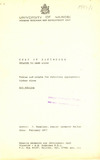| dc.description.abstract | Timber market situation in Kenya
Softwoods used in building construction in Kenya originate
from comparatively young forests. Moreover, a considerable
proportion of sawn softwood is supplied by sawmiller
holding licenses for cutting of "thinnings" only. This
leads to rather large supply of smaller sections, and a
comparative shortage of timber in larger sections.
As a consequence of the above circumstances, the cost
per unit (cubic metre) for larger cross-sectional
sizes is considerably higher than for smaller sizes.
The above applies to timber sawn in thickness of 25 mm.
(I") and over, for which the cost per unit increases
with the width of the section.
For boards under 25 mm. (1") thick, extra sawing
charges result in higher cost per unit than for
thicknesses of 25 mm. and over. But also for these
"thin boards", the cost per unit measure increases
with the width of the section.
Cost tables and cost graphs.
Price lists of the main timber suppliers in Nairobi
indicate prices per metre length for each of the
current sawn sections, in standard lengths, excluding
sales tax.
Standard random lengths mean:
1.800 to 6.000 m. by increments of 300 mm. for cyPress
and Podo;
1.800 to 4.200 m. by increments of 300 mm. for Cedar.
Whe:n specific standard lengths are required, prices are
raised by 10%.
Since 1.10.1976 no Sales Tax is due on sawn timber (unplanned).
In view of the small increments in the standard lengths
most tirober users will no doubt order timber within the
standard length range. On the other hand, most user.s
will. require specific (and not random) lengths and will,
therefore, be obliged to pay the 10% surcharge •
.-..-':
3
Based on the recently (1.10.1376) increased pricelists
of one of the main timber suppliers in the Nairobi area
(Timsales Ltd.,), cost tables have been drawn up for the
types of softwood most used in the construction industry:
CYPRESS and PINE. Also tables for PODO timber using the
increased prices valid from 17.01.1977 have been added.
To the suppliers' listed prices l~~ has been added for
orders in specific standard lengths.
For each sawn section the cost per cubic metre has been
calculated and tabulated.
In order to obtain a clear picture of the relation
between cross-sectional size and cost per cubic metre,
graph sheets show the cost of a number of thicknesses
plotted against the width of each section. | en_US |



